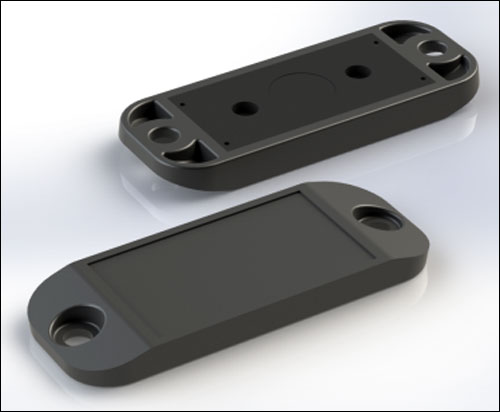RFID tag providers Vizinex and Xtreme RFID are marketing a new passive ultrahigh-frequency (UHF) tag that the two companies have designed to be more rugged, as well as higher-performing than those of competitors. The tag, known as the Allied VX-Mid, consists of Vizinex’s Sentry AST MidRange tag, using the company’s patented manufacturing process known as ViziCore, and Xtreme RFID’s ruggedization processes, to ultimately create a sturdy tag.

Vizinex, based in Allentown, Pa., sells a wide variety of passive RFID tags, including on-metal tags, to the oil and gas industry, as well as to companies that rent out equipment to construction sites or other customers, or that employ RFID for yard management. The ViziCore technology refers to the method by which the tags are manufactured, using a combination of materials and processes, according to Sandra Garby, Vizinex’s president and founder. The tags are often sold to original equipment manufacturers (OEMs) and are built into other products, and thus must sustain harsh processing, including injection molding or rubber encapsulation. The ViziCore method is intended to make the tag strong enough to protect its integrated circuit and antenna during these processes.
The tag’s ability to withstand an OEM’s manufacturing process also makes it sufficiently robust for end users in oil and gas, yard management or other industries. However, an end user’s work environment can be so tough that the tag still requires further protection. It is not unusual for the tags to be slammed by pieces of equipment, immersed in chemicals or water, and covered in ice. Vizinex had already been offering tags, such as its MidRange model, for some of these rugged applications, says Phil Koppenhofer, the company’s VP of sales and marketing. However, he adds, several users informed him that they were worried about the tag’s endurance, and especially the security of an adhesive mount.
Simply encasing the entire tag in plastic or rubber, however, was not a viable solution, Koppenhofer says. It would not be sufficiently rugged, he explains, and the tag would need to be placed directly on metal in order for it achieve the long-range reading performance that it offers, while a plastic or rubber “cap” would have made that impossible. What’s more, he adds, “We needed more than just a cap over a tag—we wanted [protective] material bonded straight to the tag.”
Vizinex met with Xtreme RFID at last year’s RFID Journal LIVE! conference and exhibition, held in Orlando, Fla., and discussed Vizinex’s challenge. Xtreme RFID also sells ruggedized passive UHF tags, says Mike Lewis, the firm’s business unit manager, for what it calls harsh environments. These tags are often customized for a specific use case, for such markets as manufacturing, waste and recycling, returnable transport items, agriculture and construction.
The two companies determined that a solution consisting of a Vizinex tag protected by an Xtreme RFID polypropylene encapsulation molded onto the top of the tag would make it impervious to impact, dust, water and other hazards—thereby earning it an IP68 rating—while one side of the tag could still come in direct contact with metal. “Our resin would bond completely to their tag,” Lewis states. The encapsulation would also enable the inclusion of mounts for screws, he notes, thus providing a more sturdy mounting method as an alternative to adhesives.
The result is the Allied VX-Mid tag, featuring an Alien Technology Higgs-3 chip with 512 bits of user memory. Koppenhofer describes the tag as one solid piece that is tougher than most ruggedized on-metal tags, with a long read range of 25 to 30 feet for fixed readers, or 20 to 22 feet for handhelds, consistent with other Vizinex tags. The companies are now accepting orders for the first of what they expect to be a portfolio of Allied Series tags. The debut model measures 1.1 inches by 2.3 inches, including “bump-outs” for mounting the tag, and is less than 1/4 inch in thickness. Both Vizinex and Xtreme RFID are selling the VX-Mid, and expect to develop additional tags for the Allied portfolio within the year.
The VX-Mid tag has been tested by a company using Mojix‘s STAR system of RFID hardware, designed to read EPC UHF tags at extremely long distances—for example, 600 feet. Other companies, including providers of equipment for the construction, agriculture, oil and gas and logistics sectors, are currently testing the new tag as well. To date, Koppenhofer says, all are located in the United States, though a South American firm will soon receive the tag. The VX-Mid could be used for work-in-progress tracking of metal goods manufacturing, he explains, or for the monitoring of metal containers or trailers, or other metal assets.
Xtreme RFID has also recently released a new product known as the Tag Flex, designed to conform to the contours of an item or piece of equipment that is being tagged. The Tag Flex, which measures 4.1 inches by 1.4 inches by 0.12 inch (103 millimeters by 35 millimeters by 3 millimeters), is designed not only to be flexible, but also to have high strength when being pulled, as might occur with such items as safety equipment at construction sites. Like the VX-Mid model, the Tag Flex is made with an Alien Higgs-3 chip, but in this case, the tag is designed for use on non-metallic surfaces. The Tag Flex is encased in thermoplastic elastomer materials provided by Xtreme RFID’s sister company, Noble Polymers, which also provided the protective polypropylene resins bonded to the VX-Mid tag.




